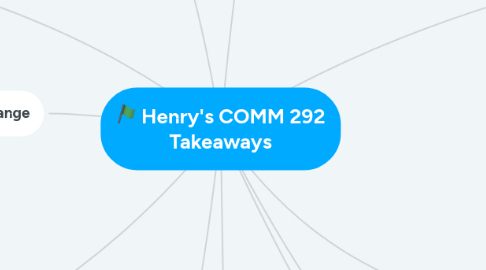
1. Perception, Personality and Emotion
1.1. Factors that affect Perception
1.1.1. Perceiver
1.1.2. Target
1.1.3. Situation
1.2. Emotion
1.2.1. Emotional Intelligence
1.2.2. Emotional Regulation
1.3. Personality
1.3.1. MBTI
1.3.2. Big 5 Personality Traits
2. Communication
2.1. Barriers to effective communication
2.2. Cultural Context
3. Organizational Change
3.1. Resistance to Change
3.1.1. Organizational
3.1.2. Individual
3.2. Overcoming Resistance to Change
3.3. Forces for Change
3.4. Approach to managing Change
3.4.1. Kotter's 8-step plan
3.4.2. Lewin's 3-step model
4. Conflict and Negotiation
4.1. Difference in Negotitating
4.1.1. Individual
4.1.2. Cultural
4.2. Bargaining Strategies
4.2.1. Distributive
4.2.2. Integrative
4.3. Conflict Management Strategies
4.3.1. Forcing
4.3.2. Problem Solving
4.3.3. Avoiding
4.3.4. Yielding
4.3.5. Compromising
5. Power and Politics
5.1. Power
5.1.1. Bases of Power
5.1.1.1. Formal Power
5.1.1.2. Personal Power
5.1.2. Empowerment
5.1.3. Influence Tactics
5.2. Politics
5.2.1. Impression Management
5.2.2. Ethics of Behaving Politically
6. Context
7. Motivation
7.1. Theories
7.1.1. Maslow's Hierarchy of Needs
7.1.1.1. Physiological
7.1.1.2. Safety
7.1.1.3. Social
7.1.2. Motivation-Hygiene Theory (Two-Factor Theory)
7.1.2.1. Intrinsic Factors
7.1.2.1.1. Job Satisfaction
7.1.2.2. Extrinsic Factors
7.1.2.2.1. Job Dissatisfaction
7.1.3. McClelland's Theory of Needs
7.1.3.1. Achievement
7.1.3.2. Power
7.1.3.3. Affiliation
7.2. Process Theories of Motivation
7.2.1. Expectancy Theory
7.2.2. Goal-setting Theory
7.2.3. Self-Efficacy Theory
7.2.4. Reinforcement Theory
7.3. Motivating Employees
7.3.1. Acquire
7.3.2. Bond
7.3.3. Comprehend
7.3.4. Defend
8. Ethics in Decision Making
8.1. Corporate Social Responsibility
8.2. Ethical Decision Criteria
8.2.1. Utilitarianism
8.2.2. Whistle-blowers
8.2.3. Justice
8.2.4. Care
9. Group and Teamwork
9.1. Types of Teams
9.1.1. Problem-solving
9.1.1.1. Typically 5-12 employees from same department
9.1.1.2. Meet few hours each week
9.1.1.3. Organized to get task done
9.1.2. Self-managed
9.1.2.1. Typically 10-15 employees
9.1.2.2. Employees have interdependent jobs and many responsibilities of manager
9.1.2.3. Less supervisory positions
9.1.3. Cross-functional
9.1.3.1. Made up of employees with same hierarchical position but different positions
9.1.3.2. Enables information exchange within organization
9.1.4. Virtual
9.1.4.1. Tie physically dispersed members using technology to achieve common goal
9.2. Stages of Development
9.2.1. 5 Stages Model
9.2.2. Punctuated-Equilibrium Model
9.3. Team Effectiveness
9.3.1. Process
9.3.2. Composition
10. Attitudes
10.1. Cognitive Component
10.1.1. Example: Employee thought he deserved promotion
10.2. Affective Component
10.2.1. Example: Employee strongly dislikes supervisor
10.3. Behavioural Component
10.3.1. Example: Complained and taken action because of dislike
11. Confederate Flag Project
11.1. Presentation Skills
11.1.1. Speaking
11.1.2. Hand Gestures
11.2. Time Management
11.2.1. Deliver task distributed from the group on time
11.2.2. Punctual to group meetings
11.2.3. Remember that there IS a group meeting
